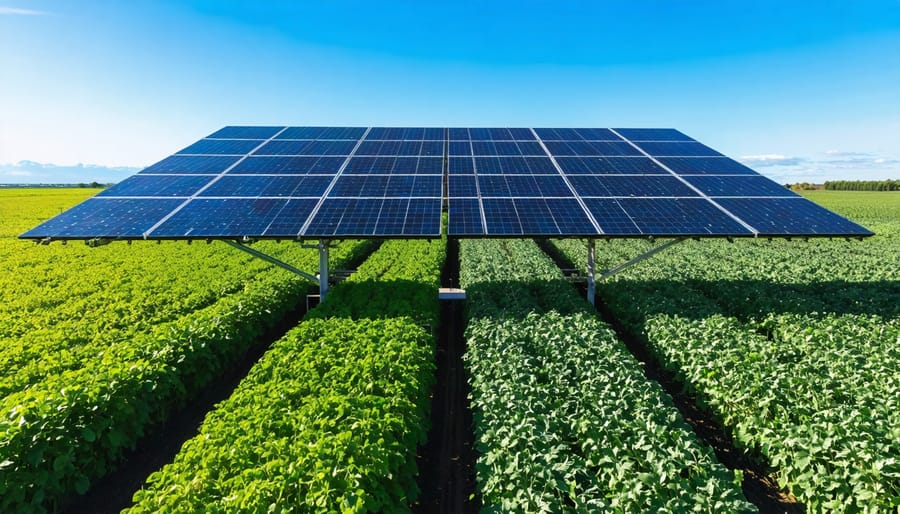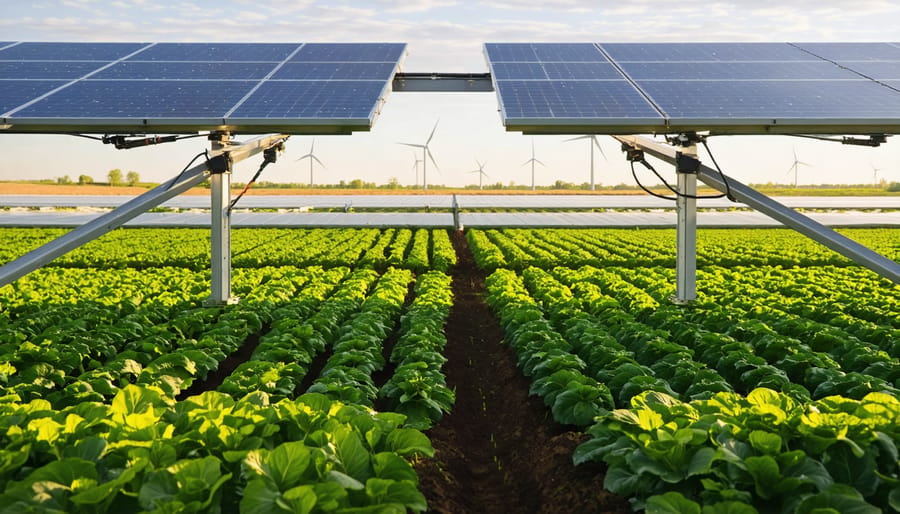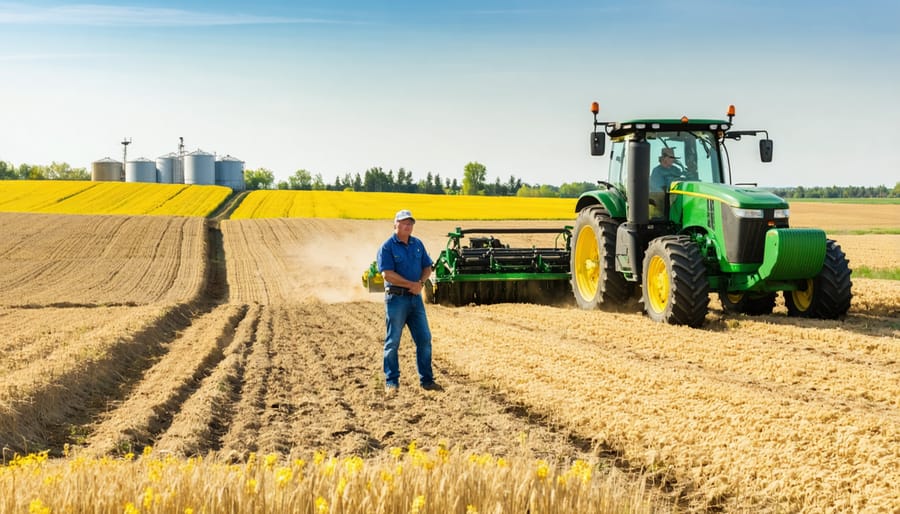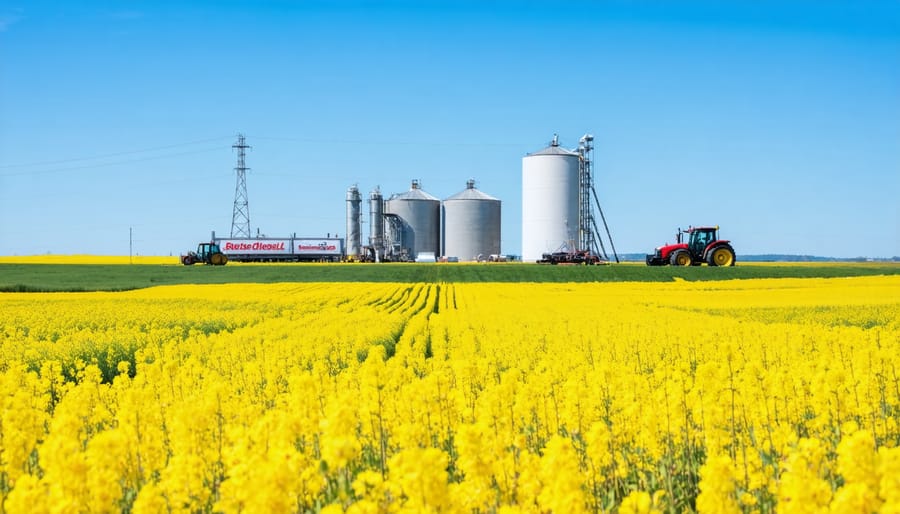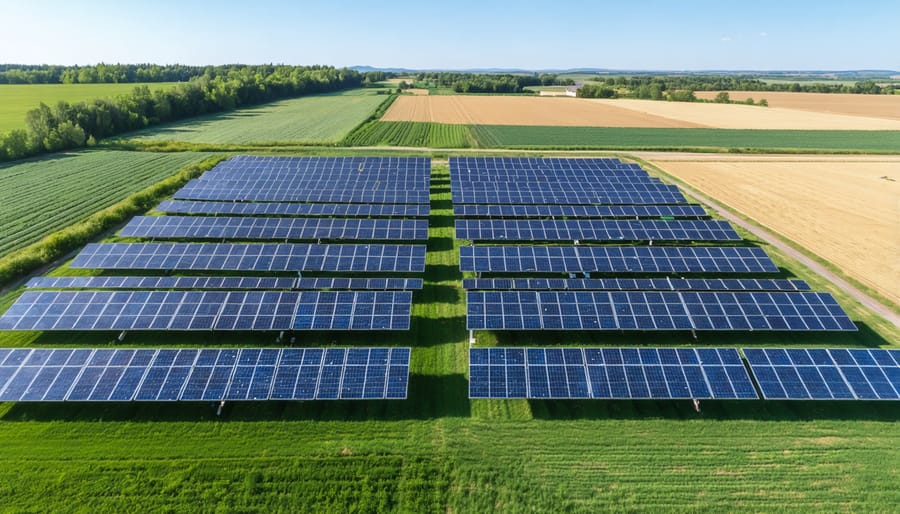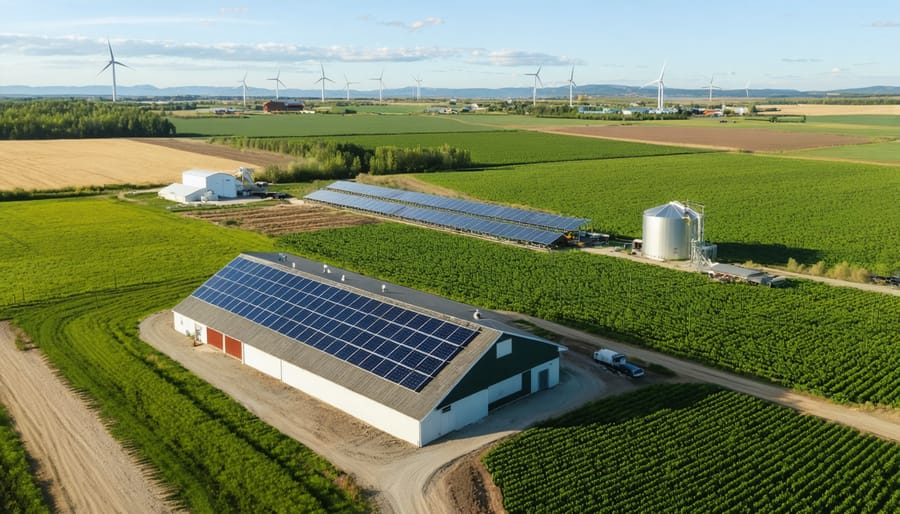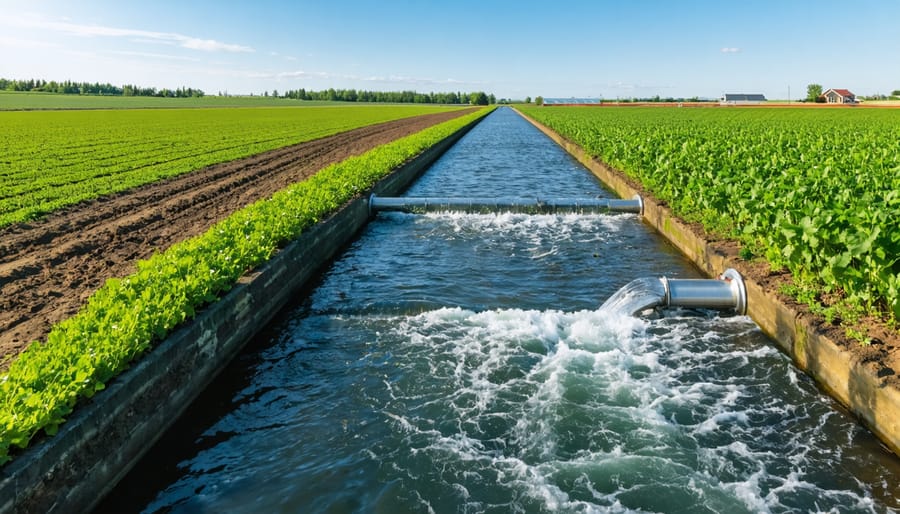As Canadian farmers face rising energy costs and climate challenges, the concept of agrivoltaics offers a groundbreaking solution that transforms agricultural land into dual-purpose powerhouses. By integrating solar panels with active farming operations, Alberta producers are discovering a remarkable synergy: crops benefit from partial shade during intense summer heat, while panels generate clean energy that slashes operational costs. Recent studies from the University of Alberta demonstrate that certain vegetables grown under solar arrays show up to 30% increased yield, while utilizing 40% less irrigation water. For forward-thinking farmers, agrivoltaics represents more than just an innovative farming practice—it’s a practical pathway to enhanced crop resilience, diversified income streams, and sustainable land management. As extreme weather events become more frequent across the prairies, this integrated approach offers a proven strategy to protect crops while generating reliable revenue through renewable energy production.
How Agrivoltaics Transforms Your Farm’s Productivity
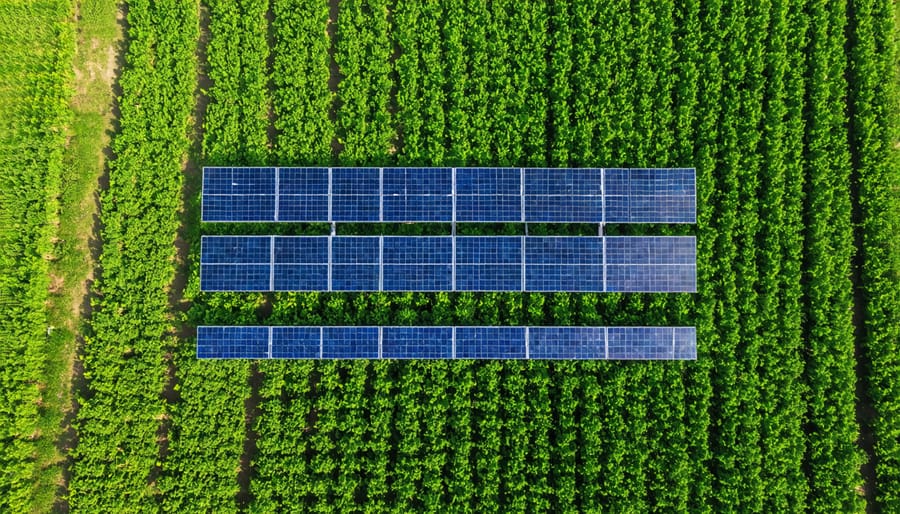
Optimize Land Use for Maximum Returns
Agrivoltaics offers a smart solution to the age-old challenge of land optimization. By installing solar panels above existing cropland, farmers can effectively double their land’s productivity, generating both food and clean energy from the same acreage. On average, Canadian farms implementing agrivoltaic systems see a 60-80% land-use efficiency increase compared to separate solar and agricultural operations.
For Alberta farmers, where land costs average $3,300 per acre, this dual-use approach makes particular economic sense. The elevated solar panels, typically installed 3-4 metres above ground, create partially shaded areas that benefit many crops, especially during intense summer heat. Crops like lettuce, berries, and certain root vegetables have shown particularly strong yields under these systems.
Research from the University of Alberta demonstrates that some shade-tolerant crops grown under solar panels use up to 30% less water while maintaining comparable yields to traditional farming methods. This efficient use of space also helps preserve valuable farmland while meeting growing energy demands, offering a practical solution for farmers looking to diversify their income without sacrificing agricultural production.
Protect Your Crops from Extreme Weather
Solar panels act as a protective shield for your crops, creating a microclimate that can help your plants thrive even during Alberta’s challenging weather conditions. By providing partial shade, panels reduce the risk of sun scalding and heat stress during intense summer days, while also offering protection against harsh winds and destructive hail storms that frequently impact our region.
Research conducted at the Olds College Smart Farm shows that crops grown under solar panels maintain more consistent soil moisture levels and experience less temperature fluctuation. During peak summer heat, temperatures under panels can be 3-5°C cooler than exposed fields, reducing water stress on plants. In winter, the panels help trap heat and can protect cold-hardy crops from extreme frost damage.
This protective environment is particularly beneficial for sensitive crops like leafy greens and berries. Local farmer Sarah Thompson from Red Deer notes, “Since installing our agrivoltaic system, we’ve seen a 40% reduction in crop damage from extreme weather events, especially during hailstorms that used to devastate our lettuce crops.”
Real Results from Alberta’s Pioneer Farms
The Thompson Family’s Solar Success Story
Located just outside of Lethbridge, Alberta, the Thompson family’s 300-hectare farm has become a shining example of successful agrivoltaic implementation in Western Canada. In 2019, Sarah and Mike Thompson took a bold step by installing solar panels above their established lettuce and spinach crops, a decision that has transformed their farming operation.
“We were skeptical at first,” admits Sarah Thompson. “But after seeing the research from the University of Alberta and speaking with agricultural extension officers, we decided to give it a try on 5 hectares.” The results exceeded their expectations. The partial shade from the solar arrays increased their leafy green yields by 23% during the intense summer months while simultaneously generating enough electricity to power their entire farm operation.
The Thompsons report that their water usage has decreased by 35% since installation, as the panels help reduce evaporation. They’ve also noticed improved crop quality, particularly during heat waves, when their lettuce shows less tip burn compared to conventional fields.
The financial benefits have been significant. Their annual energy costs have dropped by $28,000, and they’ve created an additional revenue stream by selling excess power back to the grid. The initial investment of $425,000 was offset by provincial renewable energy grants and is expected to pay for itself within six years.
“It’s not just about the numbers,” Mike explains. “We’re farming more sustainably while setting up our operation for the future.”
Measuring the Impact: Yield and Energy Data
Recent studies from Alberta’s agrivoltaic installations have shown promising results, with increased crop yields of 10-15% in shade-tolerant crops like leafy greens and root vegetables. Local farmers implementing these systems report dual benefits: enhanced agricultural production and significant energy generation.
At the Thompson Valley Farm near Lethbridge, their 2-hectare agrivoltaic system generates approximately 500 kW of electricity while maintaining productive farmland beneath. Their data shows a 20% reduction in irrigation needs due to decreased evaporation under the panels, particularly beneficial during Alberta’s hot summer months.
Energy production metrics from existing installations demonstrate annual power generation of 1,300-1,500 kWh per kW of installed capacity, enough to power approximately 150 homes. During peak summer months, when both solar generation and crop growth are at their highest, these systems operate at maximum efficiency.
Soil moisture retention has improved by 25-30% in areas beneath panels, creating more resilient growing conditions during drought periods. Temperature monitoring shows that crops under panels experience 3-5°C cooler temperatures during heat waves, reducing heat stress and crop losses.
These measurable outcomes showcase the practical benefits of agrivoltaic systems for Alberta farmers, providing concrete evidence of both agricultural and energy-production advantages in our local climate.

Financial Benefits That Matter to Your Bottom Line
Government Incentives and Support Programs
Canadian farmers interested in adopting agrivoltaic systems can access various government support programs at both federal and provincial levels. Through the Agricultural Clean Technology Program, producers can receive up to 50% funding for eligible agrivoltaic installations, with a maximum of $2 million for for-profit organizations.
In Alberta, the Energy Efficiency Alberta initiative offers specific grants for agricultural solar projects, including agrivoltaic systems. Farmers can access up to 35% of their project costs through the On-Farm Solar PV Program, making the transition more financially feasible.
The Canadian Agricultural Partnership (CAP) provides additional funding opportunities through its Environmental Sustainability and Climate Change programs. These initiatives can cover between 30-70% of eligible costs, depending on the project scope and environmental benefits.
Local agricultural societies and Rural Municipalities of Alberta (RMA) often provide supplementary support through educational resources, technical assistance, and community networking opportunities. Many municipalities also offer property tax incentives for agricultural land utilizing renewable energy systems.
To access these programs, farmers should connect with their local agricultural fieldman or contact the Alberta Agriculture and Irrigation office for guidance on application processes and eligibility requirements.
Long-term Revenue Projections
Long-term revenue projections for agrivoltaic systems demonstrate promising returns from both agricultural and energy generation streams. Based on data from Alberta test sites, farmers can expect to maintain 60-80% of their traditional crop yields while generating approximately 35-40 kWh per square metre annually from solar installations.
When analyzing financial considerations, a typical 10-hectare agrivoltaic installation can generate around $45,000 to $60,000 annually from power sales through Alberta’s micro-generation program, while still producing $30,000 to $40,000 worth of crops, depending on the chosen species and market conditions.
The dual-income stream helps stabilize farm revenues, particularly during challenging growing seasons. Over a 25-year period, the standard warranty lifetime of solar panels, farmers can expect cumulative returns of $1.8 to $2.5 million from energy generation alone, with additional crop revenues providing supplementary income.
Initial investments typically range from $800,000 to $1.2 million per 10 hectares, with various federal and provincial grant programs available to offset up to 50% of installation costs. Most systems achieve complete return on investment within 8-12 years, providing reliable income for decades thereafter.
Environmental Impact on Your Farm’s Future
Soil Health and Water Conservation
Agrivoltaic systems offer remarkable benefits for sustainable soil management practices and water conservation. The solar panels create partial shade that reduces soil moisture evaporation by up to 30%, particularly beneficial during Alberta’s hot summer months. This improved moisture retention means less irrigation is needed, helping farmers conserve water and reduce operating costs.
The panels also protect soil from wind erosion and extreme weather events, maintaining valuable topsoil that’s essential for crop productivity. During heavy rainfall, the panels help regulate water distribution, preventing soil compaction and runoff. This controlled environment promotes healthy soil microbial activity and organic matter development.
Many Alberta farmers have reported improved soil structure and reduced irrigation needs after implementing agrivoltaic systems. The shade patterns created by the panels can also help maintain more consistent soil temperatures, extending the growing season and protecting crops from frost damage. This natural climate control system works particularly well for moisture-sensitive crops like leafy greens and root vegetables.
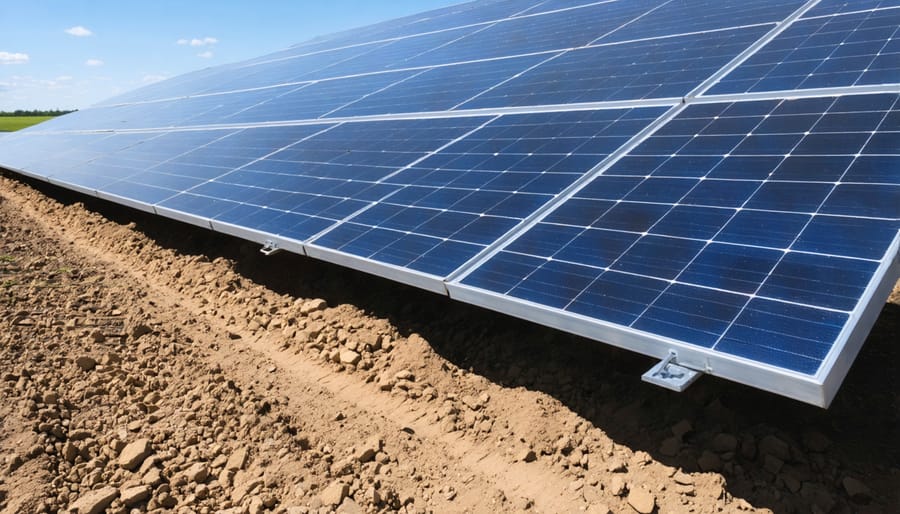
Carbon Footprint Reduction
Agrivoltaic systems significantly reduce the carbon footprint of agricultural operations while maintaining productive farmland. Studies conducted at test sites across Alberta show that a typical 1-hectare agrivoltaic installation can offset approximately 45 tonnes of CO2 emissions annually. This is equivalent to taking 10 cars off the road each year.
Beyond energy generation, these systems create additional environmental benefits through improved soil health. The partial shade provided by solar panels reduces water evaporation by 25-30%, allowing farmers to maintain soil moisture while using less irrigation. This water conservation translates to reduced energy consumption from pumping systems.
Local farmer James Peterson from Lethbridge reported a 40% reduction in his farm’s overall carbon emissions after implementing agrivoltaics on 5 hectares of his cropland. “Not only are we generating clean energy, but we’re also seeing better water retention and reduced fuel consumption from our irrigation equipment,” Peterson notes.
The dual-use approach of agrivoltaics helps preserve agricultural land while contributing to Canada’s clean energy goals, offering a sustainable solution that benefits both the environment and farm operations.
Getting Started with Agrivoltaics
Starting your agrivoltaic journey in Alberta begins with a thorough assessment of your farm’s potential. First, evaluate your land’s solar exposure and consider which fields receive consistent sunlight throughout the growing season. Most successful Alberta installations utilize south-facing plots with minimal shading from surrounding structures or trees.
Connect with local agricultural extension offices and solar installation experts who understand Alberta’s unique climate conditions. The Alberta Solar Society and various regional farming cooperatives offer valuable resources and can connect you with experienced professionals in your area.
Before installation, conduct a detailed site analysis to determine optimal panel height and spacing for your chosen crops. In Alberta’s climate, panels are typically installed 2.5 to 3 meters high to accommodate farm equipment and ensure adequate light distribution. Popular crop choices under solar arrays include shade-tolerant vegetables, berries, and certain forage crops.
Start small with a pilot project of 1-2 hectares to learn and adjust your approach. Many Alberta farmers begin with a test plot while maintaining traditional farming practices on their remaining land. This approach allows for comparative analysis and risk management.
Consider joining local farmer networks specifically focused on agrivoltaics. These communities share valuable insights about seasonal challenges, such as managing spring snowmelt and adapting irrigation systems. The Agrivoltaic Association of Alberta hosts regular workshops and field days where you can learn from established operations.
Remember to research available grants and incentives. The Alberta government offers various renewable energy programs that can help offset initial installation costs. Working with an experienced agricultural financial advisor can help you navigate funding options and develop a solid business plan.
Agrivoltaics represents a transformative opportunity for Alberta’s agricultural community, offering a sustainable path forward that benefits both our farms and our environment. Through the combination of solar energy generation and crop production, we’ve seen how this innovative approach can increase farm revenue by 15-30% while maintaining or even improving crop yields. The dual-use of land not only maximizes efficiency but also helps protect our crops from extreme weather events, which have become increasingly common across the prairies.
As we’ve explored throughout this article, the benefits are clear: improved water conservation, enhanced crop resilience, diversified income streams, and contribution to Canada’s clean energy goals. Our local success stories, from the solar-equipped greenhouses in Lacombe to the innovative grain operations near Lethbridge, demonstrate that agrivoltaics is not just a concept but a viable solution for Alberta farmers.
The time to act is now. With available government incentives and growing support from agricultural extension services, farmers have unprecedented opportunities to implement agrivoltaic systems. We encourage you to connect with local agricultural advisors, attend workshops, and join the growing community of forward-thinking farmers who are already embracing this technology.
By taking steps today to integrate solar panels with your existing agricultural operations, you’re not just investing in your farm’s future – you’re contributing to a more sustainable and resilient Canadian agricultural sector. Let’s work together to build a future where clean energy and productive farming go hand in hand.

